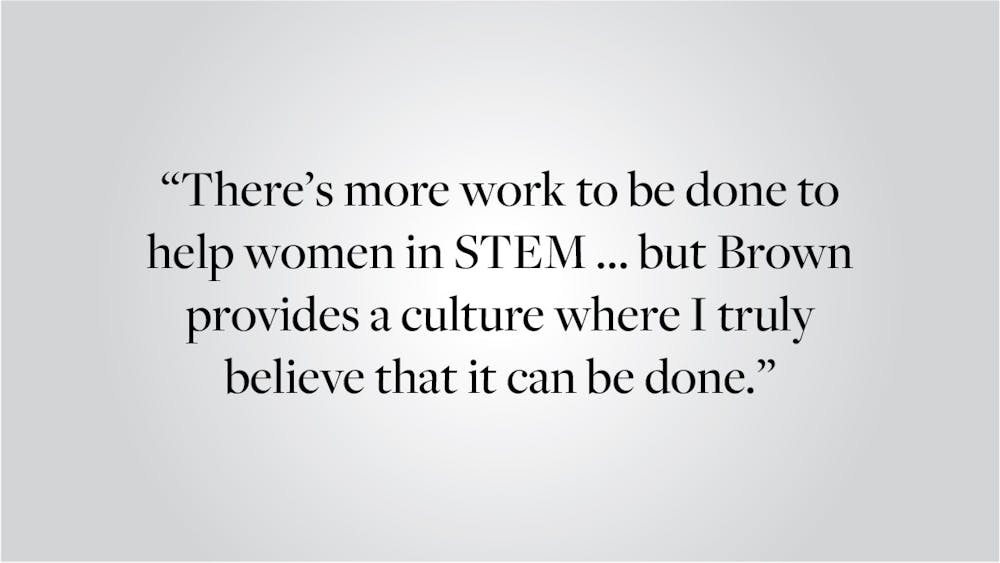After a year of online school, I was stunned when I walked into the first class of my sophomore year, an upper-level computer science lecture of 70 students. I couldn’t see a single other woman in the classroom. I scanned the room a few times, then felt relief as I found at least a couple of female students. Yet even then, I was forced to lose the blissful ignorance that Zoom had allowed. My classmates were no longer muted and faceless names on a participants list; now, they were tangible people, and I was so obviously a minority among them.
Experiences like these are extremely disconcerting, but unfortunately, they are not uncommon. Tech has seen industry-wide gender disparities since the 1980s, both in terms of women’s participation in the workforce and their compensation. The challenges that female STEM students face at Brown aren’t unique to this institution, but Brown has made valuable efforts to support its female students amid the sometimes overly competitive culture within STEM fields. Maybe women pursuing STEM degrees won’t be able to fully escape systemic disparities at Brown — I’m certainly not the first to wish for fewer gender-skewed classes — but the University deserves credit for its efforts at the departmental and institutional level to foster an environment that empowers women in the face of these challenges.
The positive results of the atmosphere Brown has created for women in STEM are self-evident: The percentage of CS undergraduates at Brown who are female in recent years (39%) is almost twice the national average (20%). Most comparable schools — including Stanford University where 34% of concentrators were women in 2020, Northeastern University where 31% of incoming undergraduates in the department in 2019 were women and Penn where 25% of CS undergraduate degrees were awarded to women as of 2014 — seem to trail slightly behind Brown in this metric. Brown’s improving numbers are contributed to by institutional leaders and alumni’s efforts to work with STEM departments to organize targeted initiatives and campaigns for gender parity.
However, as many women in STEM are all too aware, improving enrollment statistics doesn’t always translate directly into a pleasant experience in the workforce. Women face unique challenges in tech, cultivating frustration with company culture and prompting them to abandon their careers at alarming rates. This creates an unfortunate feedback loop where the lack of women in technical roles exacerbates a discriminatory culture that further discourages other women from pursuing these careers. The gender disparity that results from this cycle can even be seen at Brown, where women hold just 21.7% of faculty positions in STEM fields, The Herald previously reported.
So how can Brown possibly be the paradigm of an empowering college environment that I claim it is? One particular memory comes to mind: In the first week of my first computer science class at Brown, a student asked on Campuswire (a question-asking forum similar to Piazza, Ed or Canvas) about how the class would foster an inclusive environment for women. I don’t know what answer I expected from the professor, but his reply ended up being a carefully considered and thorough 2,000-word response. It not only addressed the original student’s concerns question by question, but it also meticulously detailed the specific steps he had taken to create a positive learning experience.
The professor had clearly put a lot of time into making sure this student felt heard. That made me feel heard as well. But more than that, in his reply, he thanked her, saying that valuable questions like hers enhanced the course. This was the first of many small gestures which convinced me that Brown’s community is passionate about supporting women in STEM meaningfully and tangibly rather than performatively or superficially.
The resources available to women pursuing STEM at Brown are also admirable. Within classes themselves, teaching assistants are hugely influential — a fact that is certainly not lost on professors. In my experience, STEM classes I’ve taken at Brown have employed staffs of TAs that are considerably more diverse than industry demographics. Having access to female role models who excelled in the same classes I’m currently taking has always served as a huge comfort to me.
Furthermore, I learned as a TA that all TAs at Brown are required to undergo diversity and inclusion training before they interact with students. From what I’ve been able to tell, it teaches all TAs to engage empathetically and maturely with challenges that underrepresented groups face, regardless of whether they have faced these challenges themselves. On the students’ end, it’s gratifying to know that your TA is capable not only in the technical aspects of their job, but also in the social aspects; this could easily be what makes the classroom learning experience at Brown feel so secure.
On a broader scale, student organizations at Brown from Women in Science and Engineering to the Association of Women in Mathematics are strong support systems for women in these fields. Not only do they explicitly provide mentorship, advice and opportunities, but they foster a sense of community among women in STEM. Older members in these organizations at Brown have a genuine desire to help others through the obstacles, insecurities and biases that they face. This mentorship culture becomes a cycle in the best way — my older peers have consistently gone out of their way to guide me, and once I’m an upperclassman, I hope to do the same for someone else.
At the end of the day, I’ve certainly experienced difficulties as a woman in STEM, often more serious ones than online trends related to the topic, such as trending TikTok sounds, would suggest. However, Brown allows me to grapple with, voice my feelings about and process these struggles in healthy ways. There’s more work to be done to help women in STEM — stories like the one I started with make that clear — but Brown provides a culture where I truly believe that it can be done.





